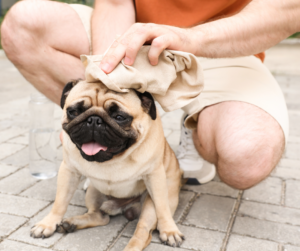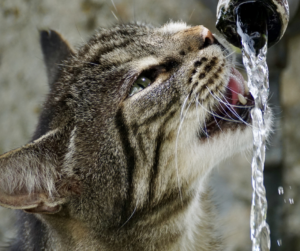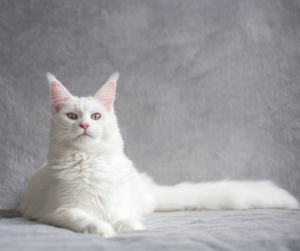Did you know that cats and dogs have a core temperature of 38°C? This is about 2 degrees higher than the normal temperature in humans! Consequently, our pets are more susceptible to suffering from high temperatures and humidity during the summer. The Bureau of Meteorology (BOM) announced that in 2024, “January to March maximum and minimum temperatures are at least 2.5 times more likely than normal to be unusually high for much of Australia.”
We are already facing multiple heatwaves in South-East Queensland and major floods on the east coast. These weather events can pose another challenge for our pets; therefore, we must be extra careful. Today we are going to discuss how the heat can affect our pets and what to do to manage it.
Heat Stroke:
Heat stroke is a life-threatening condition that occurs when a pet’s body temperature rises to a dangerous level, usually above 40°C. Dogs and cats, in particular, are more prone to heat stroke due to their limited ability to cool down through sweating.
Dogs and cats’ primary way to cool down is through panting, which is reduced when the humidity is high. The cool air travels through their airways, cooling down surrounding tissues and blood from the mouth to their lungs. Brachycephalic breeds, such as British and French Bulldogs and Persian and Exotic cats, are at an even higher risk of heat stroke. Their respiratory anatomy is very particular, with narrow nostrils, a longer soft palate, and a narrow trachea (windpipe) that makes heat exchange via panting much more difficult. Before the onset of heat stroke, animals will suffer from heat stress and heat exhaustion, which are easier to manage and can be easily controlled.
There are specific signs that tell us when your pet isn’t coping well with the heat but is still fine:
- Increased thirst and urination
- Heavy panting and less responsiveness
- Soft stools
When they continue to experience high temperatures, these signs will progress to heat stroke, which is the most severe form of increased core temperature that needs medical intervention. When this happens, many processes in the body will be disturbed because every animal’s body is adapted to function at a certain temperature. If they are too cold or too hot, enzymes and cells within the body are unable to do what they are meant to do. The additional signs of heat stroke you can see are:

- Vomiting or diarrhoea, sometimes with blood
- Lethargy and weakness
- Seizures or collapse
- Dizziness and confusion
- Heavy drooling and panting
If your pet presents any of these symptoms above when you are out for a walk or even playing in your yard, do not attempt to use icy cold water or force water down their mouth, as these can cause other serious problems like aspiration pneumonia. These pets need to have their body temperature gradually lowered, so their body can adjust to it. You can use wet towels or a hose to wet their skin.
Don’t wrap your pet around a wet towel; otherwise, the heat will be trapped and won’t dissipate. You want to continuously change the towels and provide good ventilation. You must seek veterinary attention immediately. Heat stroke can be fatal, and it might appear that your dog is getting better as they calm down, but sometimes this can be a false impression, and your dog is actually about to collapse.
Dehydration
Dehydration is a common concern in the summer months, as pets can lose fluids through panting, increased metabolism to fight high temperatures, and increased activity. It is essential to ensure that pets have access to fresh water at all times, especially during hot weather.
Dehydration can lead to serious health issues, including kidney problems. Some animals are more reluctant to drink a normal amount of water, so be familiar with how much they drink on a regular basis. As a rule of thumb, a cat or a dog should drink about 50-80ml/kg/day, meaning a 20kg dog should drink about 1L to 1.6L of water daily. These numbers will vary with the type of food they eat and their level of exercise. For a more accurate calculation, you can head to Purina’s website and check about your pet’s need to drink considering these and other factors.

There are a few ways to make your pet drink more water, such as:
- Adding water to their food (even to dry biscuits)
- Adding wet food to their diet (meat, soups, stews)
- Adding flavour to their drinking water (broth, coconut water)
- Offering ice cubes with their favourite treats inside (fruit, pieces of meat, dilute broth)
- Cleaning water bowls daily
- Using bowls made of ceramic or aluminium. Plastic bowls leave more taste in the water
- Using water fountains, especially for cats
- Playing in fresh water, like kids’ shell pools (can make them ingest more water)
Signs of dehydration include dry gums, sunken eyes, lethargy, less urination, and weakness. Another common issue in pets that don’t drink enough water is urinary tract infection, which can cause pain and progress to more severe kidney infections.
Hot Surfaces
During summer, pavement, sand, and other surfaces can become scorching hot, potentially causing burns to the sensitive paw pads of dogs and cats. Additionally, walking on hot surfaces makes them more susceptible to heat stress due to heat irradiation from the ground. So even if your feet are comfortable with that surface, your pet might not be that comfortable.
To prevent burns, walk pets during cooler times of the day or on grassy surfaces. During summer, avoid walking or exercising your pet anywhere after 9 am or before 4 pm, and when the humidity is high. This will avoid burns to their feet and also overheating. Even if you are going to the beach and your pet will be playing around or in the water, they can still get heat stress and heat stroke!
Remember, your pet is not a good decision-maker! If they love their walks, they’ll always get excited when they see their lead or when you call them or when you open the car door. The same as kids, they don’t know what can happen to them, so don’t let them decide when to go out for walks and how much to play!
Sunburn
Pets, especially those with light-coloured fur or thin coats, can suffer from sunburn. Just like in humans, prolonged exposure to the sun’s ultraviolet (UV) rays can damage the skin. Areas with less fur, such as the nose, ears, and belly, are particularly vulnerable. In Queensland, it is common to see skin carcinomas, hemangiomas, and melanomas in dogs and cats caused by constant exposure to UV light. White-skinned pets should actually live inside or in shade at all times, as they have absolutely no protection (there is no melanin), and they are still exposed to UV radiation in the shade.

Skin tumours caused by UV light need to be surgically removed and spread through the body. Sometimes surgery is not completely curative if we are not able to remove all tissue affected. Unfortunately, many dogs and cats are euthanized every year because of these types of tumours, even after multiple surgeries. To protect pets from sunburn, limit their sun exposure during peak hours, provide shade, and apply pet-safe sunscreen to exposed areas regularly throughout summer (multiple times a day).
By being aware of these summer hazards and taking proactive steps to prevent them, pet owners can ensure that their dogs and cats enjoy a safe and comfortable summer. Regular observation, proper care, and a quick response to any signs of distress are key to keeping our pets happy and healthy during the warmer months.